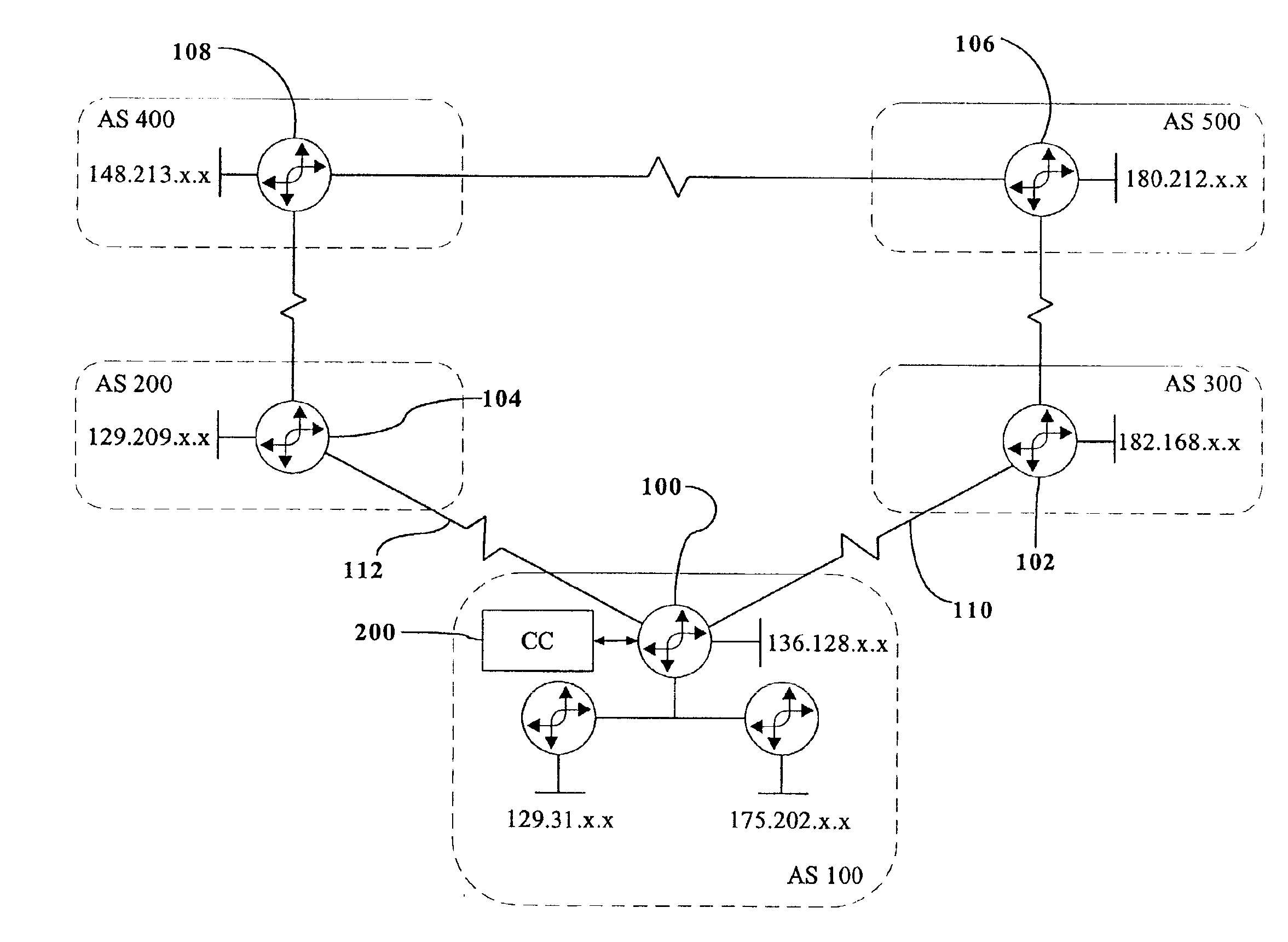[0024]In a further embodiment of the system, the blocks of network layer protocol addresses are dynamically re-divided by moving one or more blocks from one link to a different link based, at least in part, upon the incoming traffic usage of any of the whole link or the address block specifically.
[0025]In a further embodiment of the system, the congestion control unit determines an outgoing traffic link for a communication session between a destination host external to the first autonomous system and a source host internal to the first autonomous system based upon any of. load of each link over a predetermined interval of time, congestion of each link over a predetermined interval of time, capacity of each link, usage price of the link or proximity of said destination host to said source host for each of said links. The congestion control unit then provides an indicator in a field of outgoing packets of the session to indicate to the one or more border routers to route the outgoing packets through the outgoing link. Alternatively, the congestion control unit configures the one or more border routers to route outgoing packets of the session from the source host through the outgoing link.
[0026]In another embodiment of the present invention, an article of manufacture is provided comprising storage media having software code embodied therein for dynamically controlling traffic distribution across links between one or more border routers of a first autonomous system and peer border routers of other autonomous systems. The software code comprises a first plurality of binary values for logically dividing a network within the first autonomous system into two or more blocks of network layer protocol addresses; a second plurality of binary values for dynamically determining an incoming traffic link for each of the blocks of network layer protocol addresses based upon any of: load of each of the links over a predetermined interval, congestion of each of the links over a predetermined interval capacity of each of the links, usage price of the link or incoming traffic usage of the corresponding block of network layer protocol addresses over a predetermined interval; and a third plurality of binary values for causing each block of network layer protocol addresses to be announced in a manner that biases incoming traffic towards the optimal incoming traffic link of the block. One such manner is announcing blocks of network layer protocol addresses across non-optimal incoming traffic links via a Border Gateway Protocol update message having two or more local AS numbers pre-pended thereto. A second such manner is by announcing aggregated blocks on all links, while announcing more specific blocks across single links.
[0027]In a further embodiment of the article of manufacture, the software code further comprises a plurality of binary values for monitoring incoming traffic usage for each of the links over a predetermined period of time. Alternatively, it further comprises a plurality of binary values for collecting this information periodically from the one or more local routers or remote peering routers.
[0028]In a further embodiment of the article of manufacture, the software code further comprises a plurality of binary values for dynamically re-dividing the blocks of network layer protocol addresses and moving one or more blocks from one link to a different link based at least in part upon the incoming traffic usage of any of the whole link or the specific block.
[0029]In a further embodiment of the article of manufacture, the software code further comprises a plurality of binary values for determining, for a communication session between a destination host external to said first autonomous system and a source host internal to said autonomous system, an outgoing traffic link for the session based upon any of load of each link over a predetermined interval of time, congestion of each link over a predetermined interval of time, capacity of each link, usage price of the link or proximity of said destination host to said source host for each of said links. To route outgoing packets of the session through the outgoing link, the software code further comprises a plurality of binary values for providing an indicator in a field in outgoing packets of the session to indicate to the one or more border routers to route the packets through the outgoing link. Alternatively, the software code further comprises a plurality of binary values for configuring the one or more border routers to route outgoing packets of the session from the source host through the outgoing link.
 Login to View More
Login to View More  Login to View More
Login to View More 


